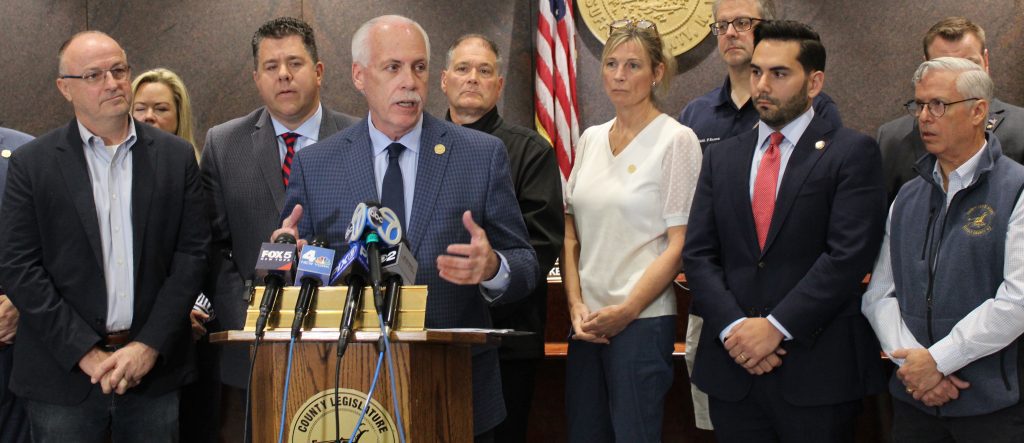On Tuesday, May 16, the polls opened for Huntington residents to vote in their respective school districts on the proposed budgets for the upcoming year and open board of education seats.
Northport‒East Northport
The Northport-East Northport Union Free School District budget for 2023‒24 passed by a vote of 1,839 to 1,315.
This year’s total budget is $183,038,428, up $5,182,344 from last year’s $177,856,084, which is a 2.91% increase. The tax levy increases from $150,628,324 to $153,632,970. This is a rise of $3,004,646 (2.26%).
A proposition permitting the use of $2,374,944 from Capital Reserve Funds for roof replacements, HVAC renovations and asbestos abatement passed by a vote of 2,449 to 693.
The board of education trustee race resulted in the reelections of Donna McNaughton and David Badanes, with 2,275 and 2,174 votes, respectively. Challenger Amanda Cascio received 1,147 votes.
“It’s just an honor to represent the community,” McNaughton said in an interview following the announcement of the results. She said that she was very appreciative that the voters saw her as a good candidate.
“We just have a lot of hard work to do,” Badanes said. He expressed that with the proposition permitting the several projects throughout the district and with the superintendent planning to retire by the end of the year, he knows that there will be a lot on the board’s plate, but he’s excited to get to work.
Cascio, who only decided to run five weeks ago, said that she would consider running again in the future, but that she will have to wait to see where everything stands next year. “I’m not counting it out,” she said.
Cascio acknowledged that it was a long shot to win this year with only five weeks of preparation, but that it was overall a good experience. “I’m pretty proud of the effort that me and my husband and the other people that helped work with us put forward,” she said. “This was a lot of footwork in a short amount of time.”
Huntington
The Huntington Union Free School District budget for 2023‒24 passed by a vote of 1,184 to 192. This year’s total budget is $146,347,091, up $3,378,748 from last year’s $142,968,343, which is a 2.36% increase. The tax levy increases from $112,718,438 to $113,711,800. This is a rise of $993,362, resulting in a 0.88% tax levy increase.
A proposition allowing the use of $5,935,000 from the Building Improvement Fund to be used for various repairs and projects on school district properties passed by a vote of 1,201 to 159.
For the board of education, incumbents Xavier Palacios and Kelly Donovan were each reelected, receiving 963 and 875 votes, respectively. Amaru Jones came in third with 651 votes.
Elwood
The Elwood Union Free School District budget for 2023‒24 passed by a vote of 1,278 to 508.
This year’s total budget is $73,077,631, up $3,896,560 from last year’s $69,181,071, which is a 5.63% increase. The tax levy increases from $51,096,360 to $52,092,739. This is a rise of $996,379, resulting in a 1.95% tax levy increase.
Proposition 2, which allows the district to use $500,000 in capital reserve funds to provide additional security enhancements throughout the district, passed by a vote of 1,473 to 349.
For the two open seats on the Board of Education, incumbents Tom Scarola and Sara Siddiqui won, receiving 1,228 and 1,179 votes, respectively. Challengers Erin Aebisher and Chris Fox received 609 and 458 votes, respectively.
Commack
The Commack Central School District budget for 2023‒24 passed, 1,247 to 351.
This year’s total budget is $222.110,181, up $7,464,854 from last year’s $214,645,327, which is a 3.48% increase. The tax levy increases from $149,681,444 last year to $152,660,104. This would be a rise of $2,978,660, resulting in a 1.99% tax levy increase.
Incumbents William Hender and Susan Hermer ran unopposed for their seats on the school board. Hender received 1,283 votes and Hermer 1,303.
Cold Spring Harbor
The Cold Spring Harbor Central School District budget for 2023‒24 passed by a vote of 779 to 392.This year’s total budget is $77,141,053, up $3,720,630 from last year’s $73,420,423, which is a 5.07% increase. The tax levy increases from $67,565,094 last year to $69,558,264. This is a rise of $1,993,170, resulting in a 2.95% tax levy increase.
The board of education trustee election was close. With three seats open, five candidates ran, one of them being incumbent Tara Belfi. Kate DelliCarpini, William Wollman and Lisa Smith were ultimately elected to the three seats. The results were as follows: Kate DelliCarpini, 617; William Wollman, 616; Lisa Smith, 599; Tara Belfi, 542; Nicholas Cerrone, 535.
Harborfields
The Harborfields Central School District budget for 2023‒24 passed by a vote of 1,273 to 286.
This year’s total budget is $96,259,671, up $3,363,676 from last year’s $92,895,995, which is a 3.62% increase. The tax levy increases from $70,626,770 to $72,190,754. This is a rise of $1,563,984, resulting in a 2.21% tax levy increase.
President Christopher Kelly and board member David Steinberg were each reelected to the board of education. The results were as follows: Kelly, 1,146; Steinberg, 1,085; Meghan Grote Shear, 356; Rose Wyka, 377.





































